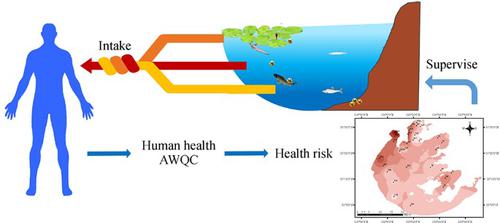Frontiers of Environmental Science & Engineering ( IF 6.1 ) Pub Date : 2021-07-12 , DOI: 10.1007/s11783-021-1475-6 Liang Cui 1 , Ji Li 1 , Xiangyun Gao 1 , Jiawen Zhang 1 , Xiaonan Wang 1 , Zhengtao Liu 1 , Biao Tian 2

|
Heavy metals are widely concerning because of their toxicity, persistence, non-degradation and bioaccumulation ability. Human health ambient water quality criteria (AWQC) are specific levels of chemicals that can occur in water without harming human health. At present, most countries do not consider the effects of aquatic vegetables in deriving human health AWQC. Therefore, the intake of aquatic vegetables (Brasenia schreberi) was added to the derivation of human health AWQC and a health risk assessment for 13 heavy metals in Taihu Lake. The human health AWQC (consumption of water, fish and aquatic vegetables) values of 13 heavy metals ranged from 0.04 (Cd) to 710.87 µg/L (Sn), and the intake of B. schreberi had a very significant effect on the human health AWQC for Cu, with a more than 62-fold difference. The hazard quotients of As (2.8), Cd (1.6), Cr (1.4) and Cu (4.86) were higher than the safe level (HQ = 1), indicating that As, Cd, Cr and Cu in Taihu Lake posed a significant health risk. Sensitivity analysis showed that the contribution rate of B. schreberi intake to the human health risk from Cu was 91.6%, and all results indicated that the risk of Cu in B. schreberi to human health should be of particular concern. This study adds the consideration of aquatic vegetable consumption to the traditional method of human health AWQC derivation and risk assessments for the first time, and this approach can promote the development of risk assessments and water quality criteria.
中文翻译:

太湖13种重金属人体健康环境水质标准及健康风险评估
重金属因其毒性、持久性、不可降解性和生物积累能力而受到广泛关注。人类健康环境水质标准 (AWQC) 是指在不危害人类健康的情况下可以在水中出现的特定化学物质水平。目前,大多数国家没有考虑水产蔬菜对人体健康AWQC的影响。因此,水生蔬菜的摄入量(莼菜)加入到人类健康AWQC的推导和太湖13种重金属健康风险评估。13 种重金属的人类健康 AWQC(水、鱼和水生蔬菜的消耗量)值范围从 0.04(Cd)到 710.87 µg/L(Sn),以及B. schreberi的摄入量Cu对人体健康AWQC有非常显着的影响,相差62倍以上。As(2.8)、Cd(1.6)、Cr(1.4)和Cu(4.86)的危害商数均高于安全水平(HQ=1),说明太湖中As、Cd、Cr和Cu对健康风险。敏感性分析表明,臭虫摄入量对Cu对人体健康风险的贡献率为91.6%,所有结果表明,臭虫中Cu对人体健康的风险应受到特别关注。本研究首次在人类健康AWQC推导和风险评估的传统方法中加入了对水生蔬菜消费的考虑,这种方法可以促进风险评估和水质标准的发展。











































 京公网安备 11010802027423号
京公网安备 11010802027423号